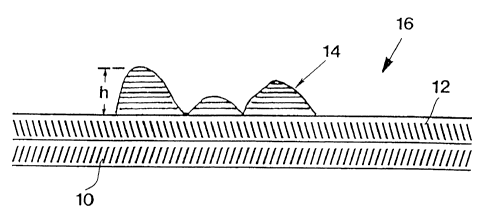Some of the information on this Web page has been provided by external sources. The Government of Canada is not responsible for the accuracy, reliability or currency of the information supplied by external sources. Users wishing to rely upon this information should consult directly with the source of the information. Content provided by external sources is not subject to official languages, privacy and accessibility requirements.
Any discrepancies in the text and image of the Claims and Abstract are due to differing posting times. Text of the Claims and Abstract are posted:
| (12) Patent: | (11) CA 2304351 |
|---|---|
| (54) English Title: | STRIP-SHAPED MOULD FOR PRODUCING SURFACE MATERIALS AND METHOD OF PRODUCING SUCH A MOULD |
| (54) French Title: | MOULE EN FORME DE BANDE POUR LA FABRICATION DE MATERIAUX SURFICIELS ET METHODE DE FABRICATION D'UN TEL MOULE |
| Status: | Deemed expired |
| (51) International Patent Classification (IPC): |
|
|---|---|
| (72) Inventors : |
|
| (73) Owners : |
|
| (71) Applicants : |
|
| (74) Agent: | MARKS & CLERK |
| (74) Associate agent: | |
| (45) Issued: | 2007-01-30 |
| (86) PCT Filing Date: | 1998-09-21 |
| (87) Open to Public Inspection: | 1999-04-01 |
| Examination requested: | 2003-05-26 |
| Availability of licence: | N/A |
| (25) Language of filing: | English |
| Patent Cooperation Treaty (PCT): | Yes |
|---|---|
| (86) PCT Filing Number: | PCT/EP1998/006018 |
| (87) International Publication Number: | WO1999/015325 |
| (85) National Entry: | 2000-03-20 |
| (30) Application Priority Data: | ||||||
|---|---|---|---|---|---|---|
|
The invention relates to a strip-shaped mould cavity
with a structured surface, for producing surfacing
materials, especially melamine resin surfaces in the
manufacture of laminated plastic sheets. According to the
invention, a flexible strip of paper or film is provided
with a layer for separating the surfacing material, some
slightly cross-linked areas being formed. A three-
dimensional mould structure consisting of UV-hardening
printing colours is also applied to the separating layer.
L'invention concerne une matrice sous forme de bande pour produire des matériaux de surface, notamment de surfaces en résine de mélamine, lors de la fabrication de panneaux stratifiés, à surface structurée. Selon cette invention, une bande (10) de papier souple ou une pellicule est munie d'une couche (12) la séparant du matériau de surface, ce qui donne lieu à des zones faiblement réticulées sur lesquelles est appliquée une structure de moulage tridimensionnelle d'encres d'imprimerie qui cuisent lorsqu'elle sont exposées aux U.V.
Note: Claims are shown in the official language in which they were submitted.
Note: Descriptions are shown in the official language in which they were submitted.

For a clearer understanding of the status of the application/patent presented on this page, the site Disclaimer , as well as the definitions for Patent , Administrative Status , Maintenance Fee and Payment History should be consulted.
| Title | Date |
|---|---|
| Forecasted Issue Date | 2007-01-30 |
| (86) PCT Filing Date | 1998-09-21 |
| (87) PCT Publication Date | 1999-04-01 |
| (85) National Entry | 2000-03-20 |
| Examination Requested | 2003-05-26 |
| (45) Issued | 2007-01-30 |
| Deemed Expired | 2015-09-21 |
There is no abandonment history.
| Fee Type | Anniversary Year | Due Date | Amount Paid | Paid Date |
|---|---|---|---|---|
| Application Fee | $300.00 | 2000-03-20 | ||
| Maintenance Fee - Application - New Act | 2 | 2000-09-21 | $100.00 | 2000-03-20 |
| Registration of a document - section 124 | $100.00 | 2000-08-14 | ||
| Maintenance Fee - Application - New Act | 3 | 2001-09-21 | $100.00 | 2001-07-06 |
| Maintenance Fee - Application - New Act | 4 | 2002-09-23 | $100.00 | 2002-09-12 |
| Request for Examination | $400.00 | 2003-05-26 | ||
| Maintenance Fee - Application - New Act | 5 | 2003-09-22 | $150.00 | 2003-08-12 |
| Maintenance Fee - Application - New Act | 6 | 2004-09-21 | $200.00 | 2004-09-08 |
| Maintenance Fee - Application - New Act | 7 | 2005-09-21 | $200.00 | 2005-07-28 |
| Maintenance Fee - Application - New Act | 8 | 2006-09-21 | $200.00 | 2006-08-30 |
| Final Fee | $300.00 | 2006-11-14 | ||
| Maintenance Fee - Patent - New Act | 9 | 2007-09-21 | $200.00 | 2007-07-24 |
| Maintenance Fee - Patent - New Act | 10 | 2008-09-22 | $250.00 | 2008-09-18 |
| Maintenance Fee - Patent - New Act | 11 | 2009-09-21 | $250.00 | 2009-09-11 |
| Maintenance Fee - Patent - New Act | 12 | 2010-09-21 | $250.00 | 2010-07-29 |
| Maintenance Fee - Patent - New Act | 13 | 2011-09-21 | $250.00 | 2011-09-09 |
| Maintenance Fee - Patent - New Act | 14 | 2012-09-21 | $250.00 | 2012-09-10 |
| Maintenance Fee - Patent - New Act | 15 | 2013-09-23 | $450.00 | 2013-07-31 |
Note: Records showing the ownership history in alphabetical order.
| Current Owners on Record |
|---|
| WKP WURTTEMBERGISCHE KUNSTOFFPLATEN-WERKE GMBH & CO. KG |
| Past Owners on Record |
|---|
| HALLER, HEINZ |
| SCHWILK, JOACHIM |